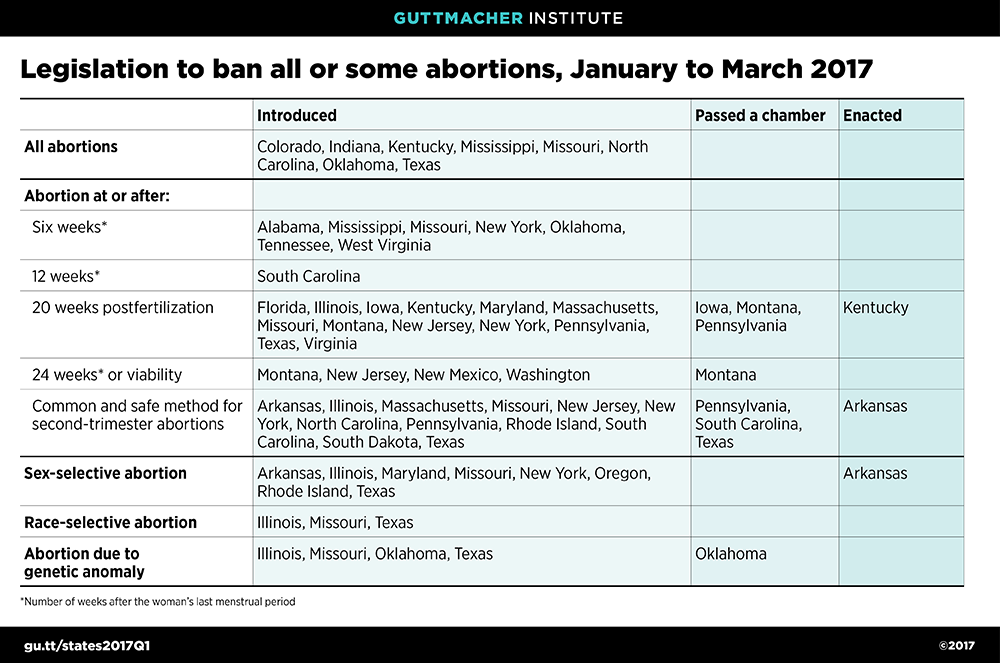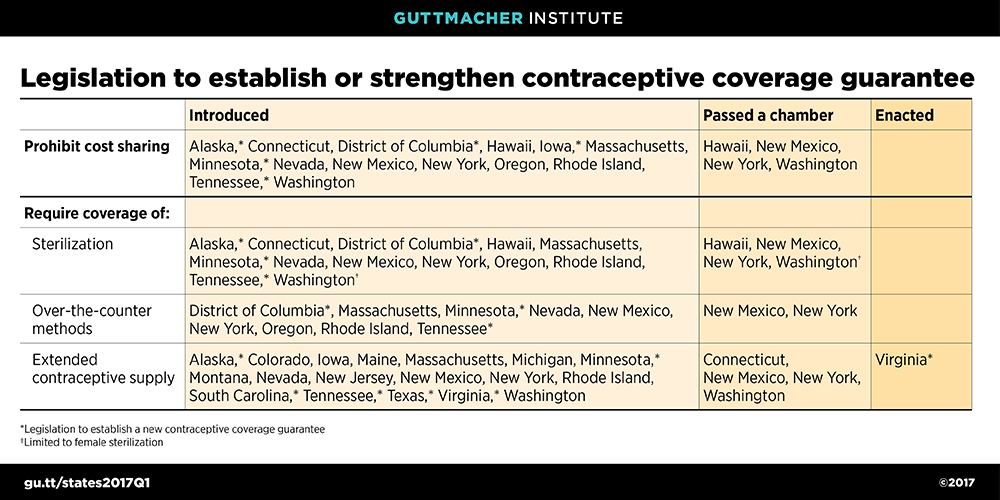The 2017 state legislative sessions are well underway, with nearly every state legislature already in session. In just the first three months of the year, legislators introduced 1,053 provisions related to reproductive health. Of these measures, 431 would restrict access to abortion services and 405 are proactive measures seeking to expand access to other sexual and reproductive health services. Although the number of abortion restrictions introduced is about on par with past years, the number of proactive measures grew from 221 in 2015 and 353 in 2016, reflecting growing interest among both advocates and policymakers.
Abortion
So far this year, five states (Arizona, Arkansas, Kentucky, Utah and Wyoming) have adopted 10 major new abortion restrictions. The new laws will:
- Ban use of a common and safe method for second-trimester procedures, as well as any abortion for purposes of sex selection (Arkansas)
- Ban all abortions at or after 20 weeks postfertilization, also defined as 22 weeks after the woman’s last menstrual period (Kentucky)
- Impose restrictions on abortion facilities (Arkansas)
- Impose requirements to preserve the life of a fetus delivered during an abortion procedure (Arizona)
- Mandate counseling on a medically unproven method to stop a medication abortion from completion after the first dose of the two-dose regimen (Utah)
- Offer a woman the option to hear the fetal heartbeat prior to obtaining an abortion (Wyoming)
- Impose ultrasound requirements for a woman seeking an abortion (Kentucky and Wyoming)
Although legislators are considering a wide range of measures to restrict access to abortion services, they appear to be paying particular attention to banning abortions in specified circumstances, perhaps in anticipation of changes to the U.S. Supreme Court that might make it more sympathetic to rolling back abortion rights.
Legislators in 28 states have introduced 88 measures that would ban abortions completely or under certain circumstances. Most in the latter category target abortions that occur after a specific point in pregnancy or that are performed for specific reasons.
By the end of the first quarter, legislation to ban procedures after the first trimester of pregnancy was moving in several states:
- Kentucky enacted a new law banning abortion at or after 20 weeks postfertilization; similar measures have passed one legislative chamber in Iowa, Montana and Pennsylvania. Including Kentucky, 17 states ban abortion at or after 20 weeks (see State Policies on Later Abortions).
- Arkansas enacted a new law banning the use of a safe method of abortion, referred to as dilation and evacuation, which is often used in second-trimester procedures, and the law is expected to go into effect in August. Similar measures have passed one legislative body in Pennsylvania, South Carolina and Texas; Mississippi and West Virginia have also banned this procedure (see Bans on Specific Abortion Methods Used After the First Trimester).
Although measures to ban abortion for purposes of race selection have been introduced in three states, none has been approved by a legislative body. The Oklahoma House approved a measure to ban abortion in cases of genetic anomaly, and Arkansas enacted a law banning abortion for purposes of sex selection.
Contraceptive Coverage
In anticipation of the possible dismantling of the Affordable Care Act and loss of its contraceptive coverage guarantee, legislators in 21 states and the District of Columbia introduced measures to ensure that these protections continue for their residents even if the federal law is repealed. Virginia was the only state to enact a measure by the end of the first quarter; its new law requires that insurance plans covering contraceptives allow enrollees to obtain a full year’s supply at one time. Currently, five states and the District of Columbia ensure coverage of an extended contraceptive supply (see States Must Act to Shore Up the Federal Contraceptive Coverage Guarantee); the Virginia law goes into effect in July. A total of 28 states ensure contraceptive coverage for their residents (see Insurance Coverage of Contraceptives).
Legislators have introduced bills this year to establish new state-level contraceptive coverage protections in seven states (Alaska, Iowa, Minnesota, South Carolina, Tennessee, Texas and Virginia) and the District of Columbia; none of these measures had passed a legislative chamber by the end of the first quarter. All these measures would guarantee coverage for reversible contraceptives, and many would go beyond to also bar cost sharing, guarantee coverage for male and female sterilization and over-the-counter methods, and allow enrollees to obtain an extended supply of their chosen method. In addition, legislators in 14 states that already had some state-level contraceptive coverage provision introduced measures to strengthen current laws by adding these types of guarantees.
In addition to the new law in Virginia, legislation to strengthen existing contraceptive coverage guarantees passed one legislative chamber in four states (Hawaii, New Mexico, New York and Washington). In New York, comprehensive legislation to strengthen an existing guarantee is moving through the legislature, while a regulation to bar cost sharing for contraceptives is also moving through the administrative process in the state.



